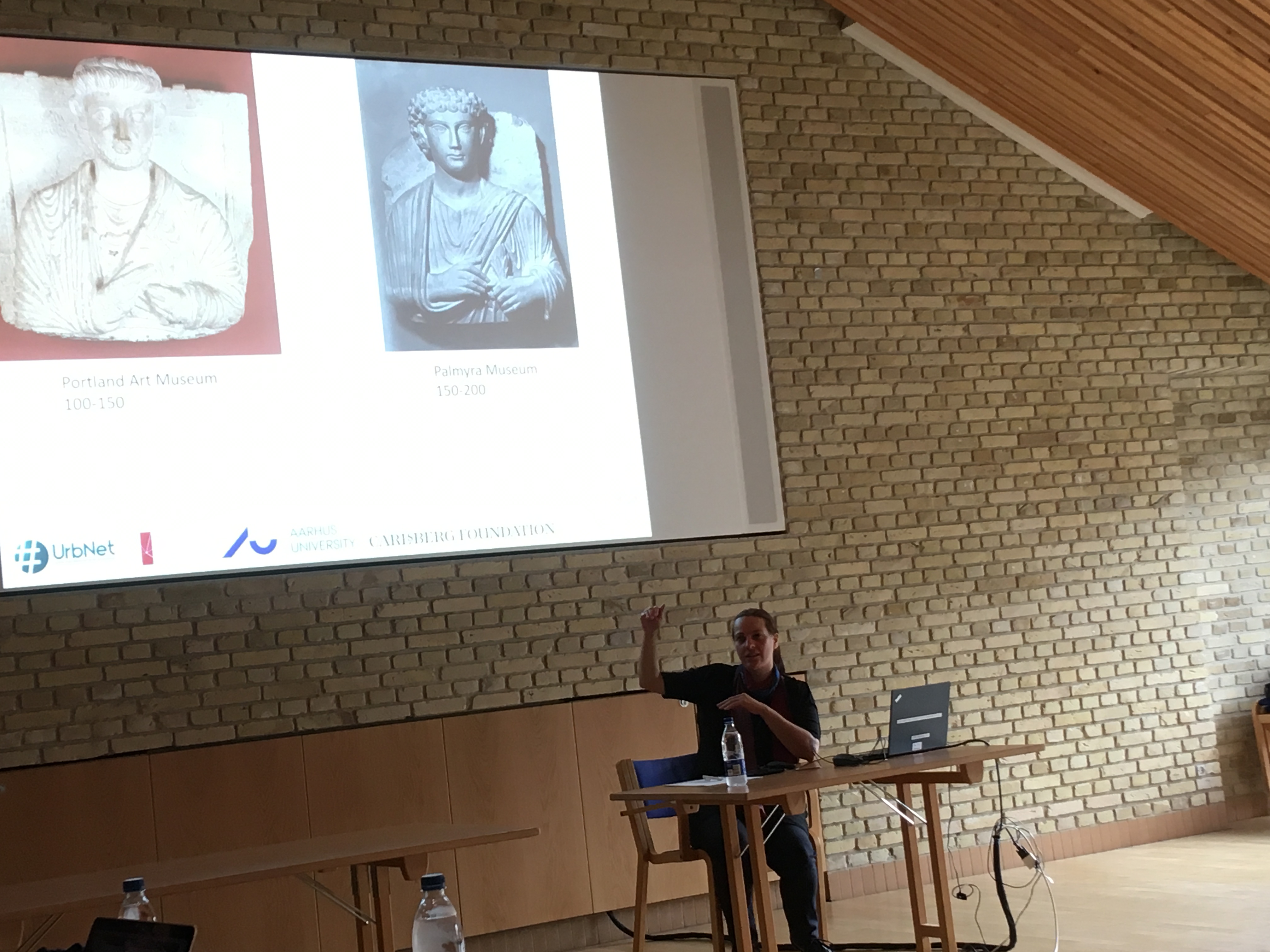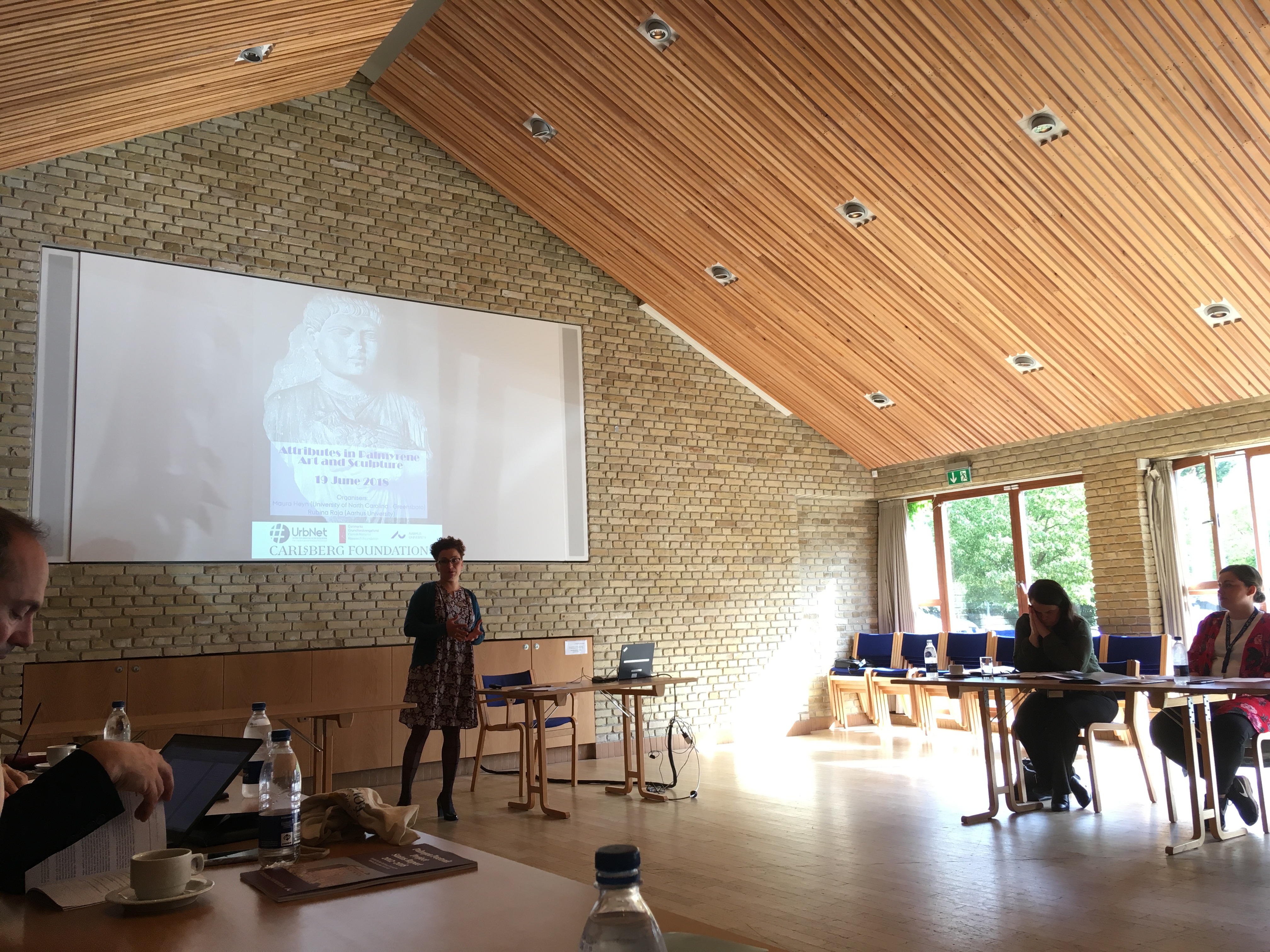Summary of the workshop “Attributes in Palmyrene Art and Sculpture”
Written by Rikke Randeris Thomsen and Julia Steding.



Written by Rikke Randeris Thomsen and Julia Steding.
“Attributes in Palmyrene Art and Sculpture” was the topic of a workshop, held on the 19th of June 2018 at Aarhus University. Professor Rubina Raja (Aarhus University) and Visiting Professor Maura Heyn (University of North Carolina – Greensboro) invited international scholars to present and discuss rather understudied details of Palmyrene Portraiture. The attributes cannot only give insight into personal choices of representation but also be used as a source of information on gender, age and status. Recurring questions during the day included whether attributes were used to communicate an identity, and if they were connected to a symbolic meaning.
The first paper, given by Olympia Bobou (Aarhus University) focused on plants and fruits; attributes that appear on approximately 140 objects. The identification of the plants can be rather hard, and the fewer times a plant is depicted, the harder it is to figure out what the sculptor had in mind when carving the object. However, some of the attributes are recognizable as laurel, palm-branches, acanthus leaves (maybe also schematic acanthus flowers), grapes, pomegranates, cones and Cyprus pines. While the plants are mainly held by men and rarely by women, grapes are also held by children.
The main question is why plants and fruits were chosen as attributes? Bobou argued, that a connection to the religious sphere is likely, seeing the depiction of palm trees next to a group of priests on the reliefs of the Temple of Bel. Further, the god Allat is holding palm branches, and cones as well as pomegranates in religious reliefs, hence supporting this thesis. Whether this was related to a cultic function or to funerary practices remain unanswered. But concluding for sure was the conscious choice of the plants as element of communication to the viewer of the grave reliefs.
The second paper focused on the coinage of Palmyra. Nathalia B. Kristensen (Aarhus University) investigated the iconography on coins in the light of eastern and western influences. In the beginning, an overview of the research history and chronology was given as well as a comparison with coinage from other regions in Syria. It turned out that the Palmyrene pieces are really light-weighted and small, and the question was raised whether they fulfilled the function of a currency or rather were used in the same way that tesserae were. Produced from the mid-second century AD in Palmyra, in bronze and copper, the iconography shows local deities and attributes related to them, alongside with e.g. lions and Tyche. In contrast to imperial coinage, they never show the image of an emperor, and the city name is only rarely imprinted. As a conclusion, Palmyrene objects cannot be placed in a purely regional, local or imperial tradition; they rather adopt images from elsewhere, mimicking them in a local manner and, therefore, giving the iconography a local meaning.
Maura Heyn (University of North Carolina – Grensboro) focused on drinking attributes in the third paper. They are most prominent in banqueting scenes, placed inside the tomb as a loculus slab. The importance of the scene is also underlined by the founder banqueting scenes with the founder inscriptions underneath. They also appear in banqueting scenes that were placed on a sarcophagus as a lid. The right hand of the reclining men is usually resting on the knee of the person, rarely holding an attribute. The left hand, in contrast, is holding an upright drinking cup. This can either be a two-handled cup, a skyphos or a shallow bowl, phiale. The decoration of both types varies to a high degree, not following any chronological development. The bowls are balanced on the fingertips, a depiction that has parallels to western Anatolia and Persia. Here, people of royal status are identified through the act of balancing a bowl in banqueting scenes. In the case of Palmyra, the symbol was rather used to refer on the high status of the deceased by drawing on the prestigious parallel. Another theory is that the banqueting scene implies that the depicted took part in the religious banquets that were held in the city. This would also mark him as a member of the elite of Palmyra. The representation as reclining person was a powerful symbol. Coming back to the drinking attributes, no relation between the depicted and the chosen drinking vessel can be seen – there is no correlation between the chosen dress and the choice of drinking attributes.
The fourth paper, given by Lukasz Sokolowksi (University of Warsaw), centered on tabulaea and schedulaea. The question raised was whether these attributes were related to everyday writing or educational aspiration. An overview of the types of writing utensils was connected with the figures holding them, and four social roles can be read from this. The main statement when choosing these attributes was definitely the ability of the deceased to read and write. The inscriptions on the reliefs prove the importance of both the Greek and Palmyrene language. The four social roles that the writing attributes in the funerary sphere could indicate were: schoolboys, citizens of a polis or the Roman Empire, entrepreneurs or tomb owners. The social role of the citizens of the polis was also underlined by a Hellenistic style of depicting. The tomb owners were probably portrayed with the legal documents of the grave, proving ownership. In conclusion, writing implements could be used to display several meanings.
Jean-Baptiste Yon (Laboratoire HiSoMa) approached the topic of attributes in Palmyrene funerary art from a different angle, asking the question “Why no attributes?” His paper focused on the Palmyrene Aramaic and Greek inscriptions, and how status could be expressed through other media than attributes. They never mention attributes that were depicted but have their own worth when it comes to representing the status and identity of the deceased. This was a conscious choice made by the person ordering a portrait. While the family was deemed important, trade and profession were not that visible in the inscriptions. Bilingual inscriptions showed a focus on different audiences: a Greek inscription was oriented towards the outside of Palmyra, mentioning the figure as Palmyrene, while the Aramaic inscription would refer to the tribe of the person rather than his Palmyrene identity.
The paper of Rubina Raja (Aarhus University) focused on the depiction of priests and attributes related to priesthood in Palmyra. While the depiction of this group has been seen as rather generic in the past, a close examination of the attributes and their variety tells a different story. In general, the priests can be categorized as either shown in action (e.g. in the public portraiture or on the tesserae), as “former” priests (men dressed as priests), and priests in constellations (e.g. on banqueting reliefs). Different attributes are connected with all of these categories. First, there is the hat that can be either worn or placed on a pedestal next to the bust. The latter category was previously seen as the depiction of former priests, but since the depictions are limited to a relatively short period in the 2nd century AD of time, it may rather correspond with a fashion phenomenon. But the hat is not the only attribute that priests were shown with. They can hold bowls, pitchers, book rolls or vegetal attributes and are often wearing a brooch. All these attributes appear in different combinations, apparently not based on any further symbolic meaning. The brooches were decorated really individually, indicating the high status of the deceased. In other cases, the priests themselves became an attribute. Depicted as little busts, they were attached to the priestly hat, maybe expressing that priesthood was part of the family history. In banqueting scenes, the standing priests behind the reclining male fulfilled the same function.
The last paper was given by Fred Albertson and focused on the “fringed” mantel and its relation to gender. It is visible on 8 of males portraits and on 15 of the female portraits and only appeared after AD 170. They visualize the identity of the deceased. The male fringed mantle is inspired by the fringed sagum, as is seen on the column of Trajan in Rome. It was a fashion that was associated with the Toman army, and the Palmyrenes adopted this, depicting themselves as men of the desert and soldiers. The female fringed mantle is comparable to the Roman palla seen on the Pudicita statue type. While the Pudicita type depicts the matron of the household, visualizing domestic virtues, this meaning was changed in the Palmyrene context and was here related to the young unmarried women. It is thereby evident that the Roman dress for men and the adaptor (Palmyra) is identical, while the female Roman dress and the adaptor is not identical. The model is the Roman dress, but the significance is changed.
All the papers were followed by lively discussions, challenging the theses of the speakers, asking for an elaboration, or exchanging ideas on the topics of attributes in Palmyrene art. The workshop was a full success and offered a great opportunity to get a better insight into the small details of Palmyrene Portraiture. The proceedings of the workshop will be published in the series “Palmyrenske Studier”, edited by Rubina Raja and published by the Royal Academy of Science and Letters Copenhagen.
